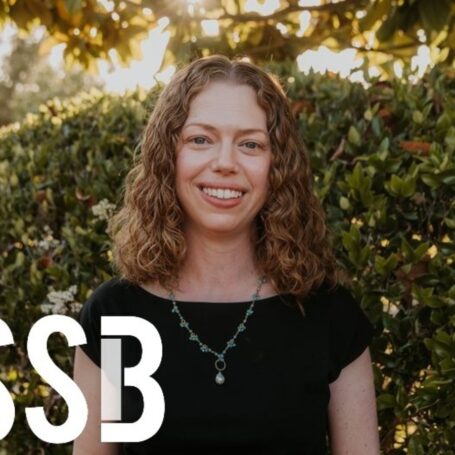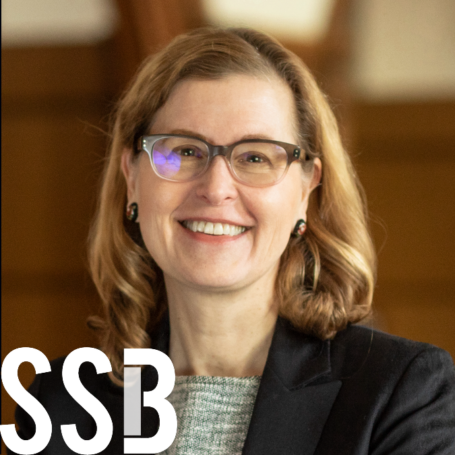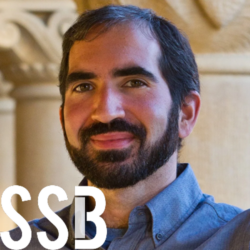Mirca Madianou on Technology and Everyday Life

LISTEN TO MIRCA MADIANOU NOW!
It’s often remarked that technology has made the world a smaller place. While this has been especially true for those with the wherewithal to buy the latest gadget and to travel at will, but it’s also true for economic migrants. Those technological ties are one of the key research interests of Mirca Madianou, a reader in the Department of Media and Communications at Goldsmiths, University of London.
In this Social Science Bites podcast, Madianou details several foundational shifts “transnational families,” those families where breadwinners — and prospective breadwinners — head far away to help support their family members back home. She’s charted both an intensification of global migration, and also the feminization of migration — women are as likely to migrate as men. And in the last decade, communication allows those women to “mother at a distance,” a very signal change from the days when the only contact a family member might be able to muster at will was a fraying photograph.
In conversation with David Edmonds, Madianou also addresses “humanitarian technologies” — the ability to reunite people pulled apart by crisis or disaster. While these technologies serve as beacons and also monitors of charitable response, they also provide a forum for emotional discharge, she explains. “… [T]his digital footprint, this digital identity, … became the focal point for mourning rituals and for grieving, and that was a very important function that social media played.”
Madianou joined Goldsmiths in 2013, and for two years before that was a senior lecturer at the University of Leicester. From 2004 to 2011 she taught at the University of Cambridge, where she was Newton Trust Lecturer in Sociology and Fellow of Lucy Cavendish College. She wrote 2011’s Migration and New Media: transnational families and polymedia (with Daniel. Miller) and 2005’s Mediating the Nation: News, audiences and the politics of identity, and was an editor for 2013’s Ethics of Media.
To directly download this podcast, right click HERE and “Save Link As.”
Click HERE to download a PDF transcript of this conversation. The full text also appears below.
Social Science Bites is made in association with SAGE Publishing. For a complete listing of past Social Science Bites podcasts, click HERE.
***
David Edmonds: Mirca Madianou, welcome to Social Science Bites.
Mirca Madianou: Hi, thanks for inviting me.
David Edmonds: The topic we’re going to talk about today is technology and everyday life. You’ve done a couple of big studies in this area. The first is to do with migration.
Mirca Madianou: Yes, well in particular, I’ve been looking at transnational families. These are families that are separated because of work. So, you have, for example, the parents working in countries like the UK, working as domestic workers or as nurses, for instance, and then the children remain in the Philippines and are looked after by other relatives or even by paid carers.
David Edmonds: So, this is mainly Filipino women coming over here to work as cleaners and so on, staying in touch with their families back in the Philippines through modern technology?
Mirca Madianou: Yes, precisely. So, transnational families have existed for a long time, but there has been a significant shift in recent years as a result of the intensification of global migration, but also the feminization of migration, and by that, I mean that women are as likely as men to migrate. Mothers migrate to countries like the UK and the children are left behind because many of these women have children.
Another big transformation in this area is that communication technologies have pretty much exploded in the last 10 years, so there are now plenty of opportunities for women to mother at a distance, and for men, I should say, as well. But, I happened to study the Philippines where the majority of migrants in recent years have been women. These new communication technologies provide opportunities for women to perform mothering at a distance.
David Edmonds: And they stay in touch with their kids through Facebook, through Skype, and have what kinds of conversations with them?
Mirca Madianou: Well, there is a very intense mothering at a distance. I use this term to describe this everyday communication that takes place throughout the day and culminates sometimes in the weekends when families leave the webcam on for hours, almost achieving a sense of co-presence.
But, just to give you an example, one of my Filipino participants would be Skyping her family every evening at about 10 o’clock when it’s early in the morning in the Philippines and the children are getting ready to go to school, and it’s the time that she might also help her sons with their homework. She will also sing songs to her daughter. Sometimes, they even play games like hide and seek using the webcam. So, there is this intense communication taking place for about an hour, sometimes less, as the children are now becoming teenagers. The communication, perhaps, is becoming shorter, and then during the day, there is this constant communication through social network updates, through texts, through reminders for her son to take his asthma medication. So, it is an ongoing sense of micromanaging the household at a distance.
David Edmonds: Most parents feel an obligation to be physically present for their children. Does this technology ease the guilt of being thousands of miles away?
Mirca Madianou: Well, we certainly see that women embrace communication technology because they see, very clearly, an opportunity to reclaim their identity as mothers, and we can only see that if we compare the situation today with the situation even 10 years ago, or 15 years ago when women would be abroad for several years in a row without any visit back home, and when they return home, the children didn’t even recognize them as mothers. There hadn’t been that kind of visual contact for a number of years. Perhaps the old photograph.
And, today, you have this constant communication, and we see that it’s very important for mothers to be recognized as mothers, that the kid back home will point at the camera and say, “This is my mom.” But we should also not lose sight of the fact that children — when we asked children, and that was very significant in our study that we spent equal times with the parents in the UK and the children back in the Philippines. The children might have a different interpretation of this situation, and they might be much more ambivalent about the consequences of this constant communication.
David Edmonds: Does this technology actually facilitate this migration, in the sense that mothers are prepared to move to different country when they wouldn’t have been before because of the possibility of staying in touch through modern technology?
Mirca Madianou: Well, that’s a very interesting question. I mean, what we have found looking at the different motivations women have when they migrate is that, usually, there is a convergence of a number of factors. Of course, there are the very well-documented economic factors, but these were hardly ever alone. Usually, they were strong personal dimensions, there was a desire to go abroad in what is generally a culture that encourages migration, and the government facilitates, promotes, regulates migration, and there is an industry of migration.
But, there was also this sense, this discourse which was present in the Philippines in public life, but it was also present very much in my participants’ narratives that now that they can mother at a distance, it is a lot easier to go abroad, and I found that very much when I looked at the reasons why women don’t return to the Philippines. Because, we have, on the one hand, of course, the question of, “why do women migrate?” but I think there is a very equally interesting question: why do they not return when this migration project is often described as a short-term project? Usually women say, “I’ll go abroad for two or three years.”
So, there is this enigma. Why do they not return? And I think the way communication technology’s become involved in justifying these decisions for migration, and even shaping this decision for migration, I think, is really important and very interesting.
David Edmonds: And are there specific aspects of this relationship mediated through technology or do they have the same kinds of tensions that you would expect in a normal parent-child relationship?
Mirca Madianou: I think, at some level, a lot of these tensions are there, and I think what is fascinating in this research is that I have been able to follow some families for almost nine years now, and so I have seen the change from women mothering children at the age of 10 to mothering teenagers, and the tensions that you would expect in a co-present household where all family members are there together are also there in this kind of mediated environment.
So, for instance, there is this teenage boy in the Philippines who would rather not answer his mother’s Skype calls because he is very much aware that the mother will comment on the untidiness of the room and the dirty plates on the table, and therefore, he would much rather text her so that he can then control the relationship in a way that would suit his needs in that particular time of his life.
David Edmonds: Can I ask you a bit about your methodology? How does this actually work? Do you go into the house once a month and set up cameras or do you have a notebook? What are you actually doing?
Mirca Madianou: This was a collaboration with Danny Miller at UCL, so this is how the research started. So, first, we worked with the mothers here in the UK, and that was more interview-based, but also involved spending time in cultural centers or church, or various institutions where they might hang out. Then, we spent a few months in the Philippines working with the children of these mothers and we were able to match 20 mothers with 20 children. And then we continued working with some of the mothers, and that’s where I have been continuing doing work now for almost nine years, and therefore, I have interview material, but I also have these everyday interaction through having a cup of tea or sharing a meal or going to somebody’s wedding, or even a baptism, but also spending time with my participants online. So, I wouldn’t say I’m just observing, but I’m also part of kind of these social interactions myself.
David Edmonds: Let me ask you about another big study you’re doing, which is to do with disasters and technology. Tell me a bit about that.
Mirca Madianou: Well, this is a project that is, in a sense, ongoing. I have been looking at the consequences of communication technologies in the context of disaster recovery, and in particular, we have been looking at the recovery from Typhoon Haiyan, and Typhoon Haiyan hit the Philippines at the end of 2013, and it remains the strongest storm ever to make landfall. So, it triggered a massive humanitarian response, and it also triggered a lot of optimism about the capacity or the potential of social and mobile media to help with disaster recovery to empower local people to take recovery into their own hands.
David Edmonds: So, the idea was that, using modern technology, people in need could access the help they required with mobile phones and so forth?
Mirca Madianou: Precisely. So, the assumption behind this term, “humanitarian technologies,” and I should say this is a term, “humanitarian technologies,” that is used by quite an influential report published by the international Red Cross, so it was in the World Disasters Report in 2013. It has then been sort of replicated in other policy documents. So, the assumption here is that interactive technologies can give a voice to disaster-affected people, and can empower them to hold humanitarian agencies into account.
David Edmonds: And is that what you found?
Mirca Madianou: Well, what we found was that the communication technologies were able to help some of our participants. It was very striking that there was this very asymmetrical distribution of voice, and by voice, I mean participation, participation in disaster recovery. So, what we found is that some of our more well-off participants were able to explore the affordances of communication technologies, the opportunities that communication technologies offered for life-enhancing activities for growing their business, rebuilding their house.
But that wasn’t at all the case with our poor participants. Our low-income participants were not really able to sort of harness that potential of social and mobile media and seemed to be left further behind, pushed further into poverty. So, we’re seeing, essentially, a widening of inequalities, really.
David Edmonds: And why was that? Presumably, most people have mobile phones, so why weren’t they able to use them and use other forms of technologies to help themselves or to get others to help them?
Mirca Madianou: There were a number of factors. One was that there was a general sort of internalized helplessness. Some participants said, “Who are we to voice our concerns?” There were also some threats. Many of these threats were simply perceived or imagined. They weren’t necessarily overt threats that have been made, but people felt that they might be struck off beneficiary lists if they protested, for instance.
More importantly, there were strong cultural norms relating to patronage, which sort of structures social relationships in the Philippines and in very strong social norms relating to a gratitude, a gratitude of inside. In the Philippines, we call it utang na loob, and that means that affected people were perceiving humanitarianism through these local idioms of patronage and obligation, and they were not really feeling able to voice any complaints or protestation. And that’s why we found, interestingly in our field states, what they called “thank you shrine.” Little shrines built with local materials like shells or pebble stones, which visibly inscribed thank you messages to the humanitarian agencies that had come.
David Edmonds: What about the NGOs themselves? They must find this technology invaluable in these kinds of situations.
Mirca Madianou: Well, the NGOs were very keen to roll out initiatives, especially relating to accountability. What was really interesting in that context is that accountability was defined very narrowly as feedback. Humanitarian agencies had various mechanisms through which they collected feedback, and the most prominent of these mechanisms was text messages. They encouraged local people to text their complaints or their feedback through texting, because mobile phones are ubiquitous in the Philippines. And what we found is that, rather than these texts being fed back into new policies addressing affected people, they were actually increasingly used as evidence that the donors increasingly demanded as impact.
David Edmonds: So, the NGOs would say we’ve got 10,000 texts just last week that proves how effective we, the Red Cross, are?
Mirca Madianou: Precisely. So, feedback becomes an exercise of audits. Essentially, it legitimates, one could say, the presence of agencies on the ground.
David Edmonds: Your findings are rather depressing in this area. One might hope that technology would facilitate support for those who’ve been affected by disaster, and the picture seems rather depressing. Is there an upside at all to this new technology?
Mirca Madianou: Yes, there is. I mean, although we found that communication technologies did not fulfill these normative assumptions about their use and their consequence, we did find that they had a really important role to play in the context of everyday life. Social media became central to mourning and memorialization rituals. We have to remember that this was a disaster that had more than 6,000 people who died, and in many of these cases, the bodies were not found, all material possessions were washed away.
So, what remained was this digital footprint, this digital identity, and that became the focal point for mourning rituals and for grieving, and that was a very important function that social media played, but it wasn’t that normative function that had been anticipated as it were by those that were rolling out the feedback programs.
David Edmonds: How do you describe your approach to these kinds of projects? You’re not really crunching numbers. It sounds like a very ethnographic approach.
Mirca Madianou: Well, that’s right. My approach is ethnographic and it’s comparative. So, I’m interested in the relationships between places like the Philippines and countries like the UK, and these are asymmetrical relationships, and I’m interested in analyzing them from the point of view of the individuals themselves.
So, to give you an example, I’m looking at very private, everyday practices like sending emails or having a conversation over Skype. But, then I try to link that to this kind of wider narrative of social transformation, and I think that’s what I particularly like about ethnography, this ability to connect the quotidian, the kind of everyday, the mundane, with these kind of wider processes.
Something else that is also very special about ethnography is the fact that it can reveal, very often, practices or processes that can be almost sort of invisible, that can be almost latent. People sometimes won’t say things openly in interviews, not because they don’t want to say them or because they’re so controversial, but also because, sometimes, they’ve not even formed specific ideas. But, it’s possible through an ethnography, through trying to connect different parts of the puzzle to really identify what is missing, what is absent.
David Edmonds: Give me an example.
Mirca Madianou: An example would be the reason why women don’t return to the Philippines. I was very interested in how women became very empowered through migration, which is not to say that they were not exploited in their workplace or they did not face very big difficulties coming here in the UK, but they felt quite empowered in relation to the gender structures that they had left back in the Philippines. So, they would tell me that now that I’m a migrant, I’m finally being respected back home because I’m sending remittances. I am a breadwinner.
But, that’s actually quite controversial to express openly, and therefore it is a lot easier to say that now that I can mother at a distance, I don’t need to go back. There are also these other factors which I have been able to explore in informal settings over a cup of coffee, for example. You wouldn’t, perhaps, capture that in a survey because a survey requires you to have either preconceptualized that, or for the participants to be ready to articulate that.
David Edmonds: There’s currently a replication crisis, they call it, in the social sciences. Studies which trumpet findings then can’t be replicated with other studies. Let’s take your project, looking at the disaster in the Philippines and you draw generalized conclusions about the world of technology and disasters. How do you know they can be generalized?
Mirca Madianou: Well, thank you for asking that because I’m now starting a new project, which is interviewing humanitarian officers involved in other recent crises, such as the refugee crisis in Europe currently taking place, or the Nepal earthquake that took place in 2015, and it seems to me that there might be some relevance in some of our arguments about technology in the context of disaster. Of course, I would like to refer judgment because this is an ongoing research, but I have a feeling that there is, increasingly, a more critical examination of technologies in this context of humanitarianism and disaster recovery.
David Edmonds: Mirca Madianou, thank you very much.
Mirca Madianou: Thank you. Thank you for having me.



























































































